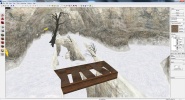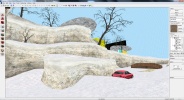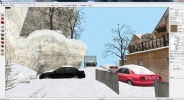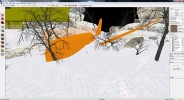It was a hard decision to break ground on Survivor because, just like de_vegas, it was never a very popular map for the original Counter-Strike. However, also like Vegas, it was somewhat of a cult classic and had a following among the hardcore Counter-Strike players who have stuck with the franchise over the years. I personally have lots of experience playing on the original de_survivor for Counter-Strike. I can remember on one occasion playing it literally all night, from dusk ’till dawn, 1v1 against a clan-mate. Obviously I am a fan of the original map, so when I was asked by the High Times servers’ community to bring it into the Source engine, the idea was immediately attractive.
However, there were apparent obstacles that would need to be overcome in order for the new map to succeed. The first of which was the sheer amount of terrain that would be required to create this map. The design of Survivor is 90% wilderness with very specific terrain that requires extensive detail to adhere to. The most important part of recreating a classic map is maintaining the angles of encounter points between players, and offering them the same floor space as the original map. So my task would be to recreate the angles and floor space from the playable area of the original map, transforming boxy, brush-based terrain into high-detail Source terrain on the way. This requires many, many patches of terrain; framerate immediately becomes a concern.
The only way I was going to be able to pull this off is if the layout offered sufficient vis-blocking to section off each area of the map. I was confident that the original layout would offer sufficent vis-blocking and decided to green-light the project.
The first thing I did was take measurements of the original de_survivor so I could make a near-exact replica with dev-textured brush work. This task was accomplished very quickly and we had a fully-functional dev-version of the map within a matter of days.
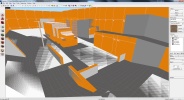
This image shows the reference geometry (white) overlayed with the world geometry of the DEV version.
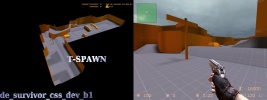
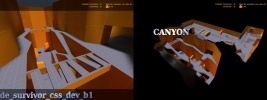
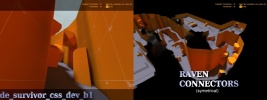
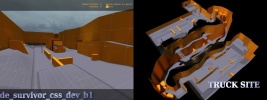
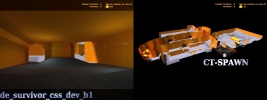
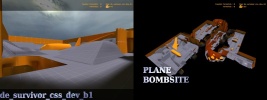
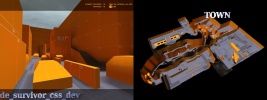
This version of the map was immediately put into rotation on the High Times server and extensive testing began. We were making sure that the scale of the map felt right in the Source engine and that the design was capable of offering competitive gameplay. When we were satisfied that the map layout was solid, the real work began. I had to replace all of the brush-based wilderness areas with Source terrain patches. This meant I had to start from scratch and sculpt the terrain for each area by hand to be as close as possible to the original terrain while still giving that high-quality Source engine feel. The first step was to replace all of the dev-version’s brushes with Source terrain-safe brushes that could be sculpted and sown together.
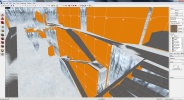
This image shows the dev-textured replica brushes (orange/grey) overlayed with the snow-textured terrain-ready brushes (snow/cliffs). Note that in this screenshot the terrain brushes have not been sculpted yet.
After 100% of the dev-textured replica brushes were replaced with terrain-safe brushes, I was ready to begin sculpting. After a hell of a lot of elbow grease, and lots and lots of subdivisions later, I finally had the entire layout created with sculpted Source terrain patches.
When sculpting the non-playable area, my objective was to give the appearance of additional routes, while keeping them un-reachable. This would avoid the claustrophobic feeling that many other maps present. In a further effort to avoid that feeling, I made sure to visually incorporate obvious alternative exits from areas of the map, blocked by smaller obstacles to prevent the player from actually using them.
One area of the map that is distinctively different from the original is the Village area. In the original version, this area was populated with that seemed to be a miniature city. You could climb the sky-scraper type buildings or hide between them for cover. However, the city’s odd scale made the map feel very awkward in the original. For this reason, my objective for the Source version was to recreate the exact floor space with a very different and more realistic visual theme. Instead of tall city buildings, this area has small cabins and mountain village architecture.
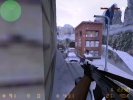
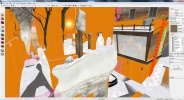
This image is the dev-version overlayed onto the final version. You can see that I replaced the odd-looking tower on the left with a natural formation that provides nearly the same amount of cover.
As soon as the terrain was finished, I started adding in details. I would have a notepad next to me when I would run through test compiles, and by the time I was done I would have 2 pages of notes on things to change/add/fix for every version that I tested. I was systematically going through each area of the map and “finalizing” them with the appropriate details. I added countless cave supports, light sources, signs, decals, and props. At this point, the only objects that were still dev-textured were the place holders for custom props; the truck and the crashed plane.
I spent an entire day modeling the truck and finalizing the truck bombsite, and an additional 2 days to do the same for the plane crash bomb site. When designing the plane, I first modeled what the plane would look like in perfect condition, and then inflicted the damage and distortion to make it appear as if it had just crashed.
After final performance optimizations, the map was officially complete and ready to go. I threw in a 3D skybox and created a map overview, then went and had a victory smoke. My next day was filled with uploading screenshots, writing descriptions, and spamming forums across the Internet with the news of my newly released map.
Over all, the release was a success. The map received very positive, yet not perfect, criticism. It is always an uphill battle to try and get Counter-Strike players to try something new and one aspect of de_survivor_css in particular that hindered its acceptance by the community was the map’s intense weather effects. Fog is something the average dust2 player has no experience with, so when a player is confronted with it, the natural reaction is to RTV the server back to de_dust2.
It was my hopes that players would become accustomed to the intense weather conditions, but on stats-centered servers the map gets RTV’ed too quickly to learn. For this reason, I will be releasing a modified version called de_survivor_pro with the fog completely removed for crystal clear visibility. This will create many new advantages for snipers, so let’s hope that the Counter-Strike: Source community was careful what they wished for.

